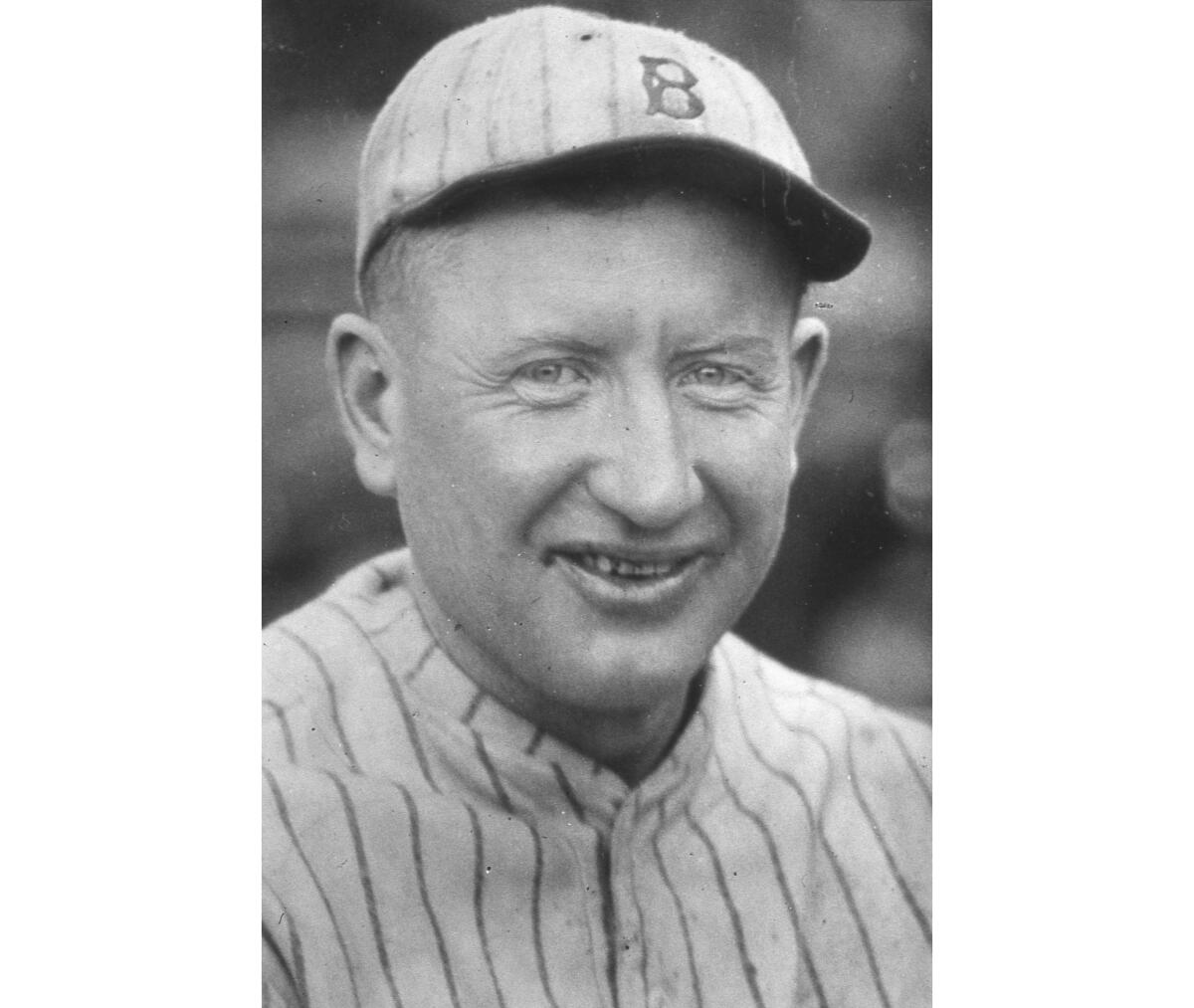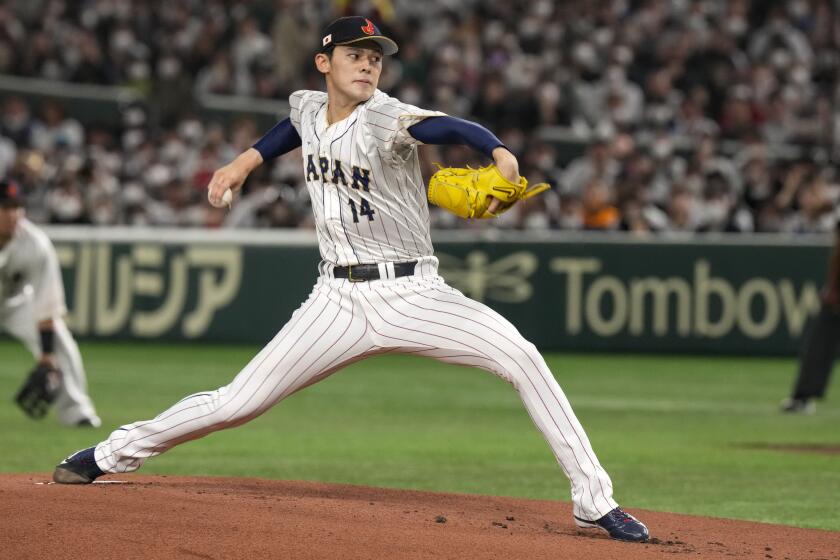Dodgers Dugout: The 25 greatest Dodgers of all time, No. 23: Dazzy Vance

Hi, and welcome to another edition of Dodgers Dugout. My name is Houston Mitchell as we continue the top 25 countdown. Tomorrow, we look at the Dodgers-Braves matchup.
Are you a true-blue fan?
Get our Dodgers Dugout newsletter for insights, news and much more.
You may occasionally receive promotional content from the Los Angeles Times.
Readers voted in droves, submitting 15,212 ballots by email, Twitter and Facebook. Voters were asked for their top 10 Dodgers in order from 1 to 10, with first place receiving 12 points, second place nine points, third place eight, all the way down to one point for 10th place.
The last time we did this was in 2018, and there were some changes in the rankings.
So, without further ado:
Enjoying this newsletter?
Your support helps us deliver the news that matters most. Become a Los Angeles Times subscriber.
The 25 greatest Dodgers, No. 23: DAZZY VANCE (2,498 points)
2018 rank: 26th
Vance really should be much higher on this list, but he pitched for the Dodgers so long ago (1922-32) that he has been forgotten by many. The best comparison to Vance is Don Drysdale.
Consider where he ranks among starting pitchers in Dodgers history: Second in WAR, sixth in ERA+, fourth in wins, fifth in strikeouts. If you were picking the all-time Dodgers rotation, he would have to be given strong consideration for a spot. He is one of eight starting pitchers in the top 25.
Charles Arthur Vance was born March 4, 1891 in Orient, Iowa. His family moved to Pleasant Hill Township, Neb., when Vance was little. When he reached high school, he started pitching for a semipro team in the area and had what was described as a dazzling fastball. That’s where he got his nickname, Dazzy.
Vance started playing professionally in 1912 in the class D Nebraska State League and quickly moved up the ranks, winning 26 games for St. Joseph (Mo.) of the class A Western League in 1914. Near the end of the season, he started four games in six days and hurt his arm. There were no MRIs then to determine his injury, but, because of how he described the way his arm felt, it is believed he suffered a torn UCL. Back then, the solution for these things was to rest your arm for a couple of weeks and try again.
Before the 1915 season, the Pittsburgh Pirates purchased his contract from St. Joseph. It is not known if they knew about his arm injury. Vance started one game for the Pirates and gave up three runs in 2-2/3 innings. The Pirates then traded him to the New York Yankees and he pitched better, with a 3.54 ERA in 28 innings. But he went 0-3, and wins and losses were all that mattered back then, so the Yankees sent him back to St. Joseph.
His arm still was hurting, and he bounced around that decade’s version of the minors for a few years. He returned to the Yankees in 1918 and had a 15.43 ERA. They got rid of him quickly and he ended up pitching in New Orleans.
And that’s when fate stepped in. Vance was playing poker and after winning a hand, he banged his elbow against the edge of the table while celebrating. The result was immediate excruciating pain. He couldn’t straighten his arm and couldn’t stand the pain. The only option was exploratory surgery. What the surgeon did has been lost to the annals of time, but after he was done and Vance recovered, his arm was 100% again. No pain when he threw. “It was an odd thing,” Vance said. “My arm came back just as quickly as it went sore on me in 1915. I awoke one morning and learned I could throw without pain again.”
Vance won 21 games for New Orleans in 1921.
After the 1921 season, the Brooklyn Dodgers were interested in a New Orleans player, but it wasn’t Vance. They wanted catcher Hank DeBerry. The Dodgers sent scout Larry Sutton to attempt to get DeBerry from the Pelicans, who told Sutton they had to take Vance too in order to get DeBerry.
According to the book “The Brooklyn Dodgers: An Informal History” by Frank Graham, this is what happened: “When he found out that the pitcher in question was Vance, Dodgers owner Charles Ebbets rebelled. ‘Oh, no. I could have drafted him long ago if I wanted him. You go back and tell them if we have to take Vance, the deal is off.’ Soon Sutton called his boss back. ‘They say, no Vance, no DeBerry.’ ‘In that case,’ Ebbets replied, ‘tell them they can …’ Sutton interrupted: ‘Wait a minute, Mr. Ebbets. I just talked to DeBerry. He wants to go to Brooklyn, naturally, but he says he don’t want to go without Vance. He says to tell you that if he looks good down here, it’s because Vance makes him look good. And, really, Daz is hot. He’s knocked around a long time and he’s learned how to pitch. And he has a fastball. A real good fastball. He’s the best pitcher in the league.’”
Ebbets acquiesced and agreed to take Vance too. And with that, the Dodgers acquired one of their best pitchers ever, a pitcher who didn’t really star in the majors until he was 31. Starting in 1922, Vance led the NL in strikeouts for seven straight seasons. He led in wins twice and ERA three times. He went 28-6 with a 2.16 ERA and 30 complete games in 34 starts in 1924 and was named NL MVP. If the Cy Young had existed back then, he would have won at least three. With Brooklyn from 1922-32, he completed 213 of 328 starts, with a 190-131 record and a 3.17 ERA. He also had eight saves.
Vance also used a secret weapon: He wore the same sweatshirt for every game and had cut the sleeves into several strips lengthwise, so when he released the ball, the batter often lost sight of it briefly as the tattered sleeves flapped with the pitch. Vance, of course, denied doing this on purpose. When opponents demanded he buy a new shirt, as Graham recounts in his book, Vance responded, “Oh, no! This is my lucky shirt. I’ve had it since I was in New Orleans, and I ain’t even washed it.”
The Dodgers traded Vance to St. Louis before the 1933 season. He was 42 and his best pitching days were behind him. He went 6-2 with a 3.55 ERA but pitched only 99 innings. He was released after the season and signed with Cincinnati, which released him after he had a 7.50 ERA in six games. The Cardinals re-signed him and he finished the season with them. His final season was in 1935, when he returned to Brooklyn, going 4-2 with a 4.41 ERA in 20 games, all in relief. He was 44. He retired after the season.
Before he retired, Vance moved himself and his family (wife Edythe, son Donald and daughter Dorothy) to Homosassa Springs, Fla., where he opened a hunting and fishing camp and a hotel. He was elected to the Hall of Fame in 1955. He learned he was elected when a highway patrolman pulled him over while he was driving near his home. The policeman told him people were waiting at his house to tell him the news.
Vance died of a heart attack on Feb. 16, 1961 and is buried at Stage Stand Cemetery just outside Homosassa Springs.
Previously
And finally
Some rare footage of Dazzy Vance. Watch and listen here.
Until next time...
Have a comment or something you’d like to see in a future Dodgers newsletter? Email me at [email protected], and follow me on Twitter at @latimeshouston. To get this newsletter in your inbox, click here.
Are you a true-blue fan?
Get our Dodgers Dugout newsletter for insights, news and much more.
You may occasionally receive promotional content from the Los Angeles Times.




